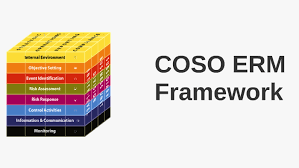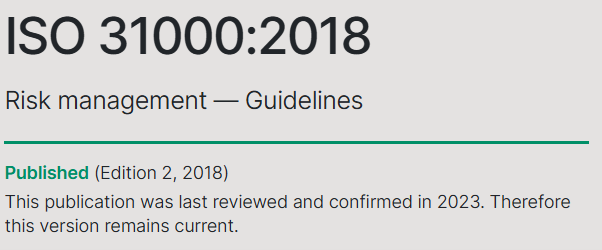
For the Risk Manager, the Article provides excellent point-by-point comparison of the strength and gaps of these two popular global standards. But that an organisation may need to consider implementation of both the standards gives rise to dilemmas for the CRO – do I need to plan and implement both these standards? Would I need to manage resources to track and monitor both sets of controls? Is there an overlap and will I be in compliance if I maintain a common set of evidences?
We would like to hear from you on your views on this. And if you wish to have a conversation with any of our standards experts or industry experts, we would be happy to facilitate. Reach out to us and we will help you in resolving your strategic imperatives.
Access the original article, interact with the Author Mr. Alex Dali on LinkedIn here.
– TrainingCentral Editor
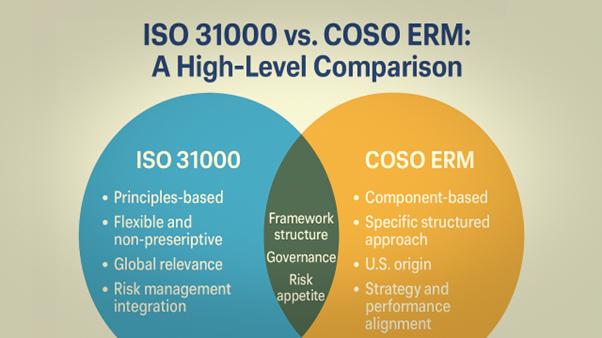
G31000 RISK INSTITUTE| © G31000 2025
Comparison and Critical Analysis of ISO 31000 and COSO ERM Framework
Based on the original work made by Rauf Aslam Butt, Group Head – Enterprise Risk Management, SSGC. Commented and reviewed by Alex Dali, G31000 Risk Institute
Link to original posting : Here
Executive Summary: comparing ISO 31000 vs COSO ERM
Based on a table created by Rauf Aslam Butt, Group Head – Enterprise Risk Management, SSGC, we have reviewed the content.
This executive summary provides a high-level comparison of the two leading risk management frameworks: ISO 31000 and the COSO ERM Framework (2017). While both aim to improve organizational resilience, performance, and governance through effective risk management, they differ in scope, structure, and application style.
- ISO 31000 is a principle-based international standard, while COSO ERM is a U.S.-developed framework with prescriptive components.
- ISO emphasizes flexibility and can be applied to any organization, industry, or any risk type globally.
- COSO provides structured integration with strategy and performance, with stronger alignment to corporate governance and internal control.
- ISO 31000 defines risk neutrally as the ‘effect of uncertainty on objectives’, while COSO focuses on (negative) events that may impact strategic goals.
- COSO includes a detailed approach to risk appetite, performance measurement, and board-level governance.
- ISO is adopted widely through national standards and is often used to guide high-level risk policies and integration, while COSO ERM was written by PwC under COSO supervision.
- COSO ERM, especially after the 2017 update, increasingly aligns with ISO’s focus on value creation and cultural embedding.
- Organizations may benefit from applying both frameworks complementarily: ISO for flexible, system-wide guidance, and COSO for governance, compliance and internal controls.
Table comparing ISO 31000 vs COSO ERM
The first three columns are part of the original table created by Rauf Aslam Butt. The new table below adds a quick evaluation of the Correctness of the original text, a few Comments and Elements to add to provide a more complete comparaison.
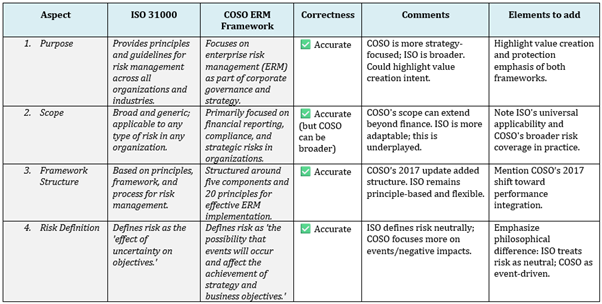
Purpose – Scope – Framework Structure – Risk Definition
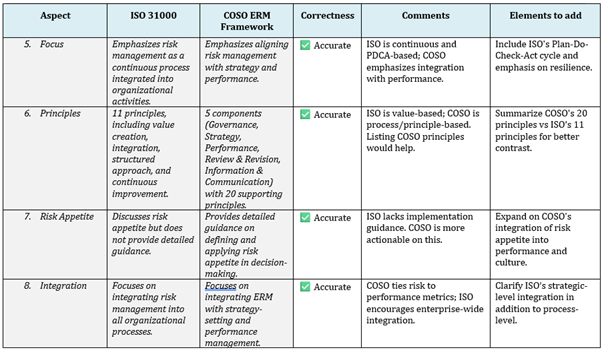
Focus – Principles – Risk Appetite – Integration
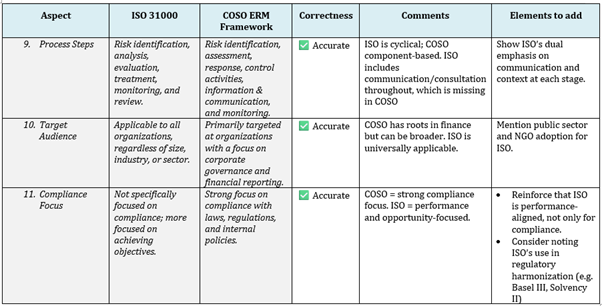
Process Steps – Target Audience – Compliance Focus
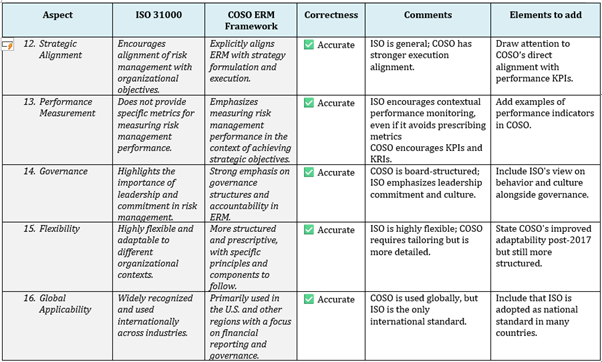
Strategic Alignment – Performance– Governance – Flexibility – Applicability
Additional Aspects Comparison: ISO 31000 vs. COSO ERM
- Cultural Emphasis
ISO 31000: Strong focus on leadership behavior and risk culture. COSO ERM: Also discusses risk culture, especially under governance.
- Audit and Assurance
ISO 31000: Can support audits but not specifically designed for it. COSO ERM: Widely used in internal audit frameworks.
- Standardization
ISO 31000: International standard (ISO 31000:2018). COSO ERM: Voluntary framework; Both guidance not intended for certification of organizations.
- Continual Development
ISO 31000: Strong emphasis via the Plan-Do-Check-Act (PDCA) cycle; continual improvement is a core principle. COSO ERM: Encourages iteration, but is less formally structured as a cycle; continual development is part of “Review & Revision.”
- Risk Maturity Model
ISO 31000: Recognizes the need for maturity assessment but does not provide a model; the G31000 Risk Institute offers one based exclusively on ISO 31000. COSO ERM: Often used with established models (e.g., AICPA/COSO Risk Maturity Model); supports structured maturity assessment.
- Stakeholder Inclusion
ISO 31000: Promotes active consultation and communication with both internal and external stakeholders. COSO ERM: Discusses stakeholder roles mostly internally (governance bodies, management); external engagement is less emphasized.
- Decision-Making Support
ISO 31000: Positions risk management as an enabler for risk-informed decisions under uncertainty at all levels. COSO ERM: Embeds risk into strategic planning and performance management decisions specifically.
- Documentation
ISO 31000: Encourages context-driven documentation; promotes integrating risk into existing processes and records. COSO ERM: Provides structured documentation practices for governance, control, and compliance reporting.
- Technology Enablement
ISO 31000: Recognizes digital tools and technology trends, but does not explicitly address them. COSO ERM: Allows integration with GRC systems, dashboards, and risk analytics tools — especially in performance tracking.
- Communication Culture
ISO 31000: Views open communication and risk culture as essential for successful implementation. COSO ERM: Emphasizes “tone at the top,” governance culture, and risk awareness across the enterprise.
- Interdependency of Risks
ISO 31000: Encourages a holistic view of risk, including cascading and interconnected effects. COSO ERM: Acknowledges risk interdependencies, particularly in relation to strategic objectives and performance.
- Implementation Guidance
ISO 31000: High-level and principle-based; must be tailored to each organization’s internal and external context. COSO ERM: More structured, with component-based implementation tools and clearer execution guidance.
- Integration with Other Management Systems
ISO 31000: Designed for integration with other ISO standards (e.g., ISO 9001, ISO 22301, ISO 14001). COSO ERM: Not designed for formal integration but can complement other governance and control systems.
Summary of Key Differences
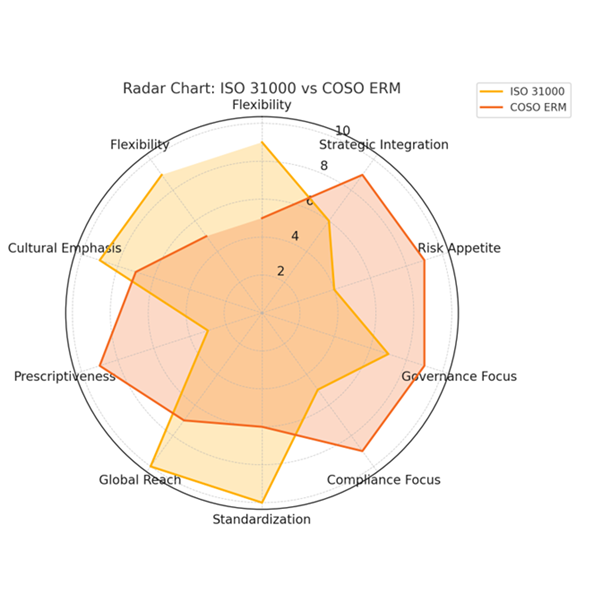
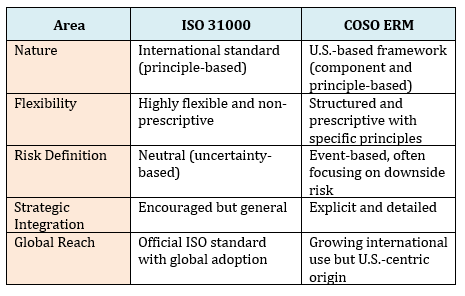
Conclusions from Rauf Aslam Butt, Group Head – Enterprise Risk Management, SSGC :
“In contrast to ISO 31000, which is a general risk management standard offering global principles and guidelines, COSO ERM is more focused on internal control, governance, and alignment with strategy, particularly in the area of financial reporting. While ISO 31000 is based on principles and is flexible in its application to any organization or industry, the COSO ERM framework features a structured cube model with detailed components and objectives. The main differences between the two frameworks can be seen in their aspects and uses.”
Best Use Cases: ISO 31000, COSO ERM, or Both
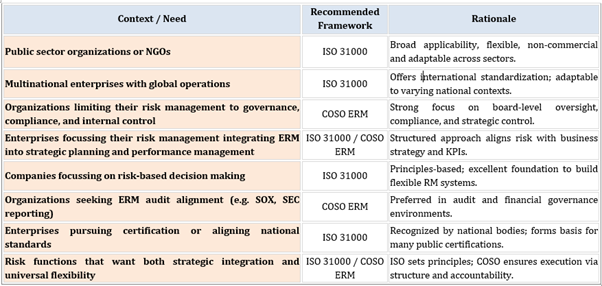
✅ Recommendation
Organizations don’t have to choose one or the other exclusively. Many leading companies integrate ISO 31000 as a foundational philosophy and apply COSO ERM to operationalize ERM within governance, compliance, and internal control. This combined approach ensures Universal adaptability (ISO), and governance, regulatory, compliance, and internal control alignment (COSO).
📝 Note on the update of COSO ERM to be more aligned with ISO 31000
The original COSO ERM Framework (2004) was primarily focused on internal control, compliance, and financial reporting. It provided a structured approach to identifying and managing risks within corporate governance.
However, the COSO ERM Framework was significantly revised in 2017, and this updated version—”Enterprise Risk Management: Integrating with Strategy and Performance”—reflects a broader and more modern view of risk management. It incorporates many elements that align closely with ISO 31000, including:
- A stronger emphasis on strategic integration of risk,
- Consideration of risk appetite as part of decision-making,
- Embedding risk into performance management processes,
- Focus on organizational culture and governance, and
- Encouragement of continuous improvement and value creation.
While COSO ERM 2017 does not explicitly cite ISO 31000, its structure and underlying philosophy show considerable convergence with the principle-based, organization-wide approach promoted by ISO 31000:2018.
This evolution illustrates a global trend toward harmonization of risk management practices, where organizations can benefit from using both frameworks in a complementary manner—leveraging the strategic depth of COSO ERM and the universal applicability and flexibility of ISO 31000.
About the authors of COSO ERM and ISO 31000
📘 COSO ERM (2017)
Title: Enterprise Risk Management — Integrating with Strategy and Performance
- Published by: The Committee of Sponsoring Organizations of the Treadway Commission (COSO)
- Lead Authoring Body: PricewaterhouseCoopers (PwC) contracted by COSO
✅ Not a single author but a collective framework developed under COSO, with technical drafting and project management by PwC.
📗 ISO 31000:2018
Title: Risk Management – Guidelines (ISO 31000:2018)
- Published by: International Organization for Standardization (ISO)
- Developed by: ISO Technical Committee ISO/TC 262 – Risk Management
- Chairperson (at time of publication): Kevin W. Knight (Australia)
- Participating national bodies included 81 countries, including Australia, France, Germany, Japan, USA, UK, Canada, China, etc.
✅ Like all ISO standards, it was developed by international consensus, coordinated by a technical committee with representatives from dozens of countries and organizations.
📄 Official Links for Referencing
- COSO ERM Framework (2017 Edition) – Title: Enterprise Risk Management — Integrating with Strategy and Performance 🔗 https://www.coso.org/Pages/erm.aspx – (COSO is a joint initiative of five private sector organizations)
2. ISO 31000:2018 – Risk Management Guidelines – Title: ISO 31000:2018(en) – Risk management — Guidelines – 🔗 https://www.iso.org/standard/65694.html – (Purchase or preview available through ISO and national standards bodies)
Countries that have adopted ISO 31000 as official national risk management standard Risk Institute and its activities
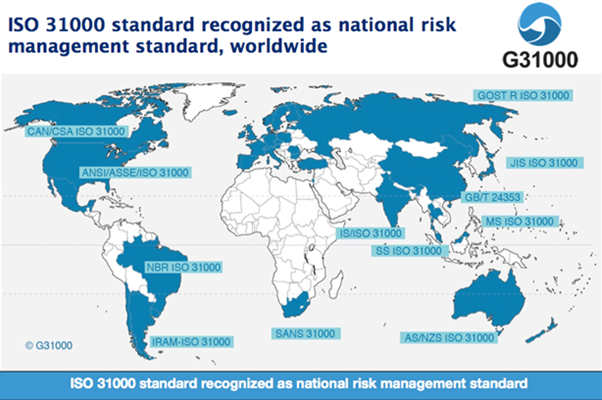
We’d Love to Hear From You
As a reader and practitioner of risk management, your insights matter. We invite you to reflect and share your perspective on the following:
- What stood out most to you in this comparison between ISO 31000 and COSO ERM?Were there any insights that confirmed or challenged your current practices?
- Do you currently use ISO 31000, COSO ERM, or both in your organization? Why did you choose one over the other — or combine them?
- Have you encountered any challenges implementing either framework? If yes, what were the biggest obstacles — integration, culture, leadership, resources?
- What benefits have you observed in using ISO 31000 or COSO ERM? How has your organization changed or improved as a result?
- Do you think there are any important aspects missing from this comparison? We welcome your suggestions for improvement or additions.
- Which framework do you find more adaptable to your sector or geography? Has global applicability or standardization influenced your choice?
- How do you see the future of risk management frameworks evolving? Is harmonization between ISO 31000 and COSO ERM realistic or desirable?
Please share your experiences, opinions, or questions in the comments or message us directly. Let’s keep the conversation around risk management alive and valuable.
For more information on the use and implementation of ISO 31000-based framework, please contact us at info@G31000.org or contact me directly
About G31000 Risk Institute
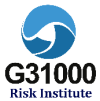
Launched in December 2011, the G31000 Risk Institute (formerly known as the Global Institute for Risk Management Standards), is an international association dedicated to raising awareness about the international ISO 31000 risk management standard. It supports events, training and certification of individuals through a network of high profiles risk professionals, worldwide.
About the Author

Alex Dali, MBA, ARM is the President and Founder of the G31000 Risk Institute, an international organization dedicated to promoting and advancing the understanding and application of the ISO 31000 risk management standard.
In his role, Alex Dali:
- Leads global efforts to promote ISO 31000 through training, certification, and advisory services;
- Has overseen the certification of thousands of professionals in ISO 31000 across more than 100 countries;
- Acts as a key educator, speaker, and advocate for risk-based decision-making and good governance;
- Developed and manages the G31000 Certified ISO 31000 Risk Manager program, one of the most widely recognized certifications in this field;
- Organizes international risk conferences and forums to connect practitioners, policymakers, and academics around ISO 31000 best practices.
- He is a Founder and respected Moderators on the LinkedIn ISO 31000 risk management discussion group which have 100,000 members
CONTACT : Alex.Dali@G31000.org
LINKEDIN : https://www.linkedin.com/in/alexdali/
PLAN A CALL https://meet.sendinblue.com/g31000
About TrainingCentral Solutions Private Limited
The Risk Management Services from TrainingCentral starts and ends with Training and encompasses services in between. Powered by a network of Risk Experts across risk standards and industries, TrainingCentral offers a comprehensive suite of offerings to take care of your Risk Management needs.
Reach out to Manoj Navalkar at manoj.navalkar@trainingcentral.co.in (+91-9821154746) for a consultation on your Risk Management requirements.


